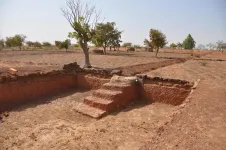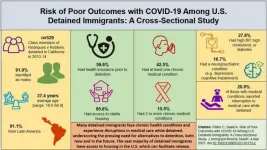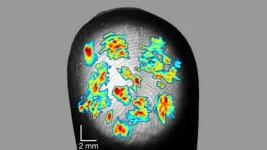INFORMATION:
Lessons learned in Burkina Faso can contribute to a new decade of forest restoration
In 2018, the West African nation decided to restore 5 million hectares of degraded land by 2030. New research shows what works - and what doesn't - when restoration coincides with degraded landscapes, pressure on natural resources and climate change
2021-03-15
(Press-News.org) Forest landscape restoration is attaining new global momentum this year under the Decade of Ecosystem Restoration (2021-2030), an initiative launched by the United Nations. Burkina Faso, in West Africa, is one country that already has a head start in forest landscape restoration, and offers valuable lessons. An assessment of achievements there and in other countries with a history of landscape restoration is critical to informing a new wave of projects aiming for more ambitious targets that are being developed thanks to renewed global interest and political will to improve the environment.
Burkina Faso has been fighting with desertification and climate change, and has seen a progressive degradation of its forested landscapes due to the expansion of agriculture. In 2018, the country planned to restore 5 million hectares of degraded land by 2030, as part of the pan-African initiative AFR100. However, the country is facing many challenges amid growing pressures on natural resources, extreme degradation processes, and changing climatic conditions. So far, restoration initiatives have only partly succeeded due to various constraints and have mainly targeted small areas when compared to the scale of landscape degradation that has happened.
In 2019, researchers at the Alliance of Bioversity International and CIAT interviewed managers of 39 active restoration initiatives in Burkina Faso to understand bottlenecks and opportunities for scaling up ongoing efforts. The initiatives examined were concentrated in the Sahelian and northern part of the Sudanian region, where most degraded lands are located. The majority of these initiatives were less than 3 years old and all aimed at bringing back tree cover in the landscape, among other objectives. They reported their findings in "Sustainability" in December.
Initiatives combined objectives that spanned from recovering ecological functions of the ecosystems, increasing resilience of local communities to climate change and enhancing productivity in agro-sylvo-pastoral systems, in alignment with national policies that promote both livelihood improvement and ecosystems conservation. Most restoration initiatives had a strong involvement of local NGOs and associations, directly engaged in managing activities on the ground, while the funding was primarily provided through multilateral or bilateral international co-operation projects.
Assisted natural regeneration, an approach well-adapted to landscapes in which old tree stumps are sufficiently present and the soil seed bank is not totally depleted, was found to be commonly used to foster tree development. It favors regrowth from existing tree stumps, through their management and protection from disturbance. It is the most cost-efficient approach and have proved to be successful for restoring vast areas in other West African countries.
Other practices, although very labor-intensive, are commonly adopted, as they are indispensable to cultivate in extreme environments where water is scarce and soil fertility limited. These consist in the creation of stone bunds, half-moons, Vallerani trenches and zaï, which are pits filled with seed and manure. Shrubs and grass were often commonly planted along with trees, as they play a role in conserving soils, creating favorable microclimates, stabilizing moisture levels, and providing forage for animals, thereby creating a benefit from the early stage of restoration activities.
Tree planting was implemented by the majority of the restoration initiatives, as natural regeneration alone is not sufficient to sustain the recovery of a tree cover in most contexts. Half of the restoration initiatives sourced at least part of their planting materials from the National Tree Seed Center, a government-run seed conservation and production research center. The center offers seeds of a large range of native species and ensures that collection practices follow best standards, guided by genetic considerations about the origin of the planting material. However, a significant number of initiatives relied exclusively on self-collected, locally procured seed, harvested from sources potentially depauperated and from a limited number of individuals available, raising concerns about quality of the planting material, its growth performance, and capacity to survive in the face of changing climatic conditions.
Participatory approaches to involve local communities were generally adopted across the initiatives examined and capacity building activities were a common denominator, however, the role of local communities in decision-making seemed still limited. Women especially tend to be excluded and have very limited land-access rights.
Despite all the critical aspects identified, the increasing number of restoration initiatives, the diversity of approaches used by local actors to overcome constraints and the support from the government are all encouraging aspects. The renewed interest of international donors in supporting the Great Green Wall for the Sahel and Sahara Initiative (GGW), an African-led initiative, involving 11 countries, to fight land degradation, desertification and drought will provide an ideal framework to achieve multiple objectives, scaling up efforts to restore degraded land, creating job opportunities, and strengthening resilience of rural communities.
ELSE PRESS RELEASES FROM THIS DATE:
Racial disparities in heart disease, hypertension, and diabetes death rates have minimally improved over last two decades
2021-03-15
In the last 20 years, Black adults living in rural areas of the United States experienced high mortality rates due to diabetes, high blood pressure, heart disease and stroke compared to white adults. According to a research letter published in the Journal of the American College of Cardiology, racial disparities improved minimally in rural areas over the last two decades, with larger improvements occurring in urban areas.
"While modest gains have been made in reducing racial health inequities in urban areas, large gaps in death rates between Black and white adults persist in rural areas, particularly for diabetes and hypertension. We haven't meaningfully ...
Telemedicine versus office-based follow-up after meniscal surgery: Trial shows 'equivalent' patient satisfaction scores
2021-03-15
March 15, 2021 - After arthroscopic surgery on the meniscus of the knee, patients using telemedicine for postoperative follow-up are just as satisfied with their care as those making in-person visits, reports a study in The Journal of Bone & Joint Surgery. The journal is published in the Lippincott portfolio in partnership with Wolters Kluwer.
"Patient satisfaction with overall care is equivalent between telemedicine and office-based follow-up after an arthroscopic meniscal surgical procedure in the immediate postoperative period," according to the randomized trial report by Christina P. Herrero, MD, and colleagues of NYU Langone Health, New York , and colleagues.
Telemedicine is 'a reasonable alternative' for postoperative visits
The ...
Immigrants in ICE detention face high risks in COVID-19 pandemic
2021-03-15
Immigrants imprisoned in immigration facilities across the country face health conditions and often have chronic illnesses that would expose them to greater risk with COVID-19, a new University of California, Davis, study suggests.
"The research is clear: immigration detention is not only unnecessary for facilitating a just immigration system, but also causes extensive harm to detained people, perhaps especially to those facing chronic health conditions," said the study's lead author, Caitlin Patler, professor of sociology. "This is particularly alarming in the context of the COVID-19 pandemic. The government must act quickly to permanently reduce reliance ...
Autism online: A review of how autistic people communicate virtually
2021-03-15
Prior to COVID-19, communication via the internet was already a regular feature of everyday interactions for most people, including those on the autism spectrum. Various studies have shown how autistic people use information and communication technology (ICT) since the early 2000s, some finding that autistic people may prefer to communicate using the internet instead of in-person. However, no systematic review has been conducted to summarize these findings.
To understand what has been discovered so far, researchers from Drexel University's A.J. Drexel Autism Institute collected and reviewed published research about how autistic youth and adults use the internet to communicate and provide a framework ...
Of mice and men and their different tolerance to pathogens
2021-03-15
(BOSTON) ¬-- Trillions of commensal microbes live on the mucosal and epidermal surfaces of the body and it is firmly established that this microbiome affects its host's tolerance and sensitivity of the host to a variety of pathogens. However, host tolerance to infection with pathogens is not equally developed in all organisms. For example, it is known that the gut microbiome of mice protects more effectively against infection with certain pathogens, such as the bacterium Salmonella typhimurium, than the human gut microbiome.
This raises the interesting possibility that analyzing differences between host-microbiome ...
Discovery of 'knock-on chemistry' opens new frontier in reaction dynamics
2021-03-15
TORONTO, ON - Research by a team of chemists at the University of Toronto, led by Nobel Prize-winning researcher John Polanyi, is shedding new light on the behaviour of molecules as they collide and exchange atoms during chemical reaction. The discovery casts doubt on a 90-year old theoretical model of the behavior of the "transition state", intermediate between reagents and products in chemical reactions, opening a new area of research.
The researchers studied collisions obtained by launching a fluorine atom at the centre of a fluoromethyl molecule - made up of one carbon atom and three fluorine atoms - and observed the resulting reaction using Scanning Tunneling Microscopy. What they saw following each collision ...
Fingerprints enhance our sense of touch
2021-03-15
Fingerprints may be more useful to us than helping us nab criminal suspects: they also improve our sense of touch. Sensory neurons in the finger can detect touch on the scale of a single fingerprint ridge, according to new research published in JNeurosci.
The hand contains tens of thousands of sensory neurons. Each neuron tunes in to a small surface area on the skin -- a receptive field -- and detects touch, vibration, pressure, and other tactile stimuli. The human hand possesses a refined sense of touch, but the exact sensitivity of a single sensory neuron has not been studied before.
To ...
Is there an association between a pregnant mother's diet and her child's weight?
2021-03-15
Key Points
19.3% of children and adolescents in the United States have obesity and therefore have a higher likelihood of having obesity as adults and developing weight-related diseases.
This AJCN study assessed how strongly mothers' diets during pregnancy were associated with their children's growth rates during specific periods from birth through adolescence.
Study results suggest maternal nutrition during pregnancy may influence her offspring's weight gain during specific periods from birth to adolescence.
A pregnancy diet with higher inflammatory potential was associated with accelerated BMI growth trajectories in children, specifically those between three and ten years of age.
Rockville, ...
European summer droughts since 2015 unprecedented in past two millennia
2021-03-15
Recent summer droughts in Europe are far more severe than anything in the past 2,100 years, according to a new study.
An international team, led by the University of Cambridge, studied the chemical fingerprints in European oak trees to reconstruct summer climate over 2,110 years. They found that after a long-term drying trend, drought conditions since 2015 suddenly intensified, beyond anything in the past two thousand years.
This anomaly is likely the result of human-caused climate change and associated shifts in the jet stream. The results are reported in the journal Nature Geoscience.
Recent summer droughts and heatwaves in Europe have had devastating ecological and economic consequences, which will worsen as the global climate continues to warm.
"We're ...
Saarbrücken based bioinformaticians trace down molecular signals of Parkinson's disease
2021-03-15
In their study, which is now published in the journal Nature Aging, they show that the level of non-coding RNAs in the blood of a Parkinson's patient can be used to track the course of the disease. For their study, the team led by bioinformatics professor Andreas Keller and his doctoral student Fabian Kern created and analyzed the molecular profiles of more than 5,000 blood samples from over 1,600 Parkinson's patients. This resulted in around 320 billion data points, which the researchers analyzed for biomarkers of Parkinson's disease using artificial intelligence methods. ...
LAST 30 PRESS RELEASES:
Tracing the quick synthesis of an industrially important catalyst
New software sheds light on cancer’s hidden genetic networks
UT Health San Antonio awarded $3 million in CPRIT grants to bolster cancer research and prevention efforts in South Texas
Third symposium spotlights global challenge of new contaminants in China’s fight against pollution
From straw to soil harmony: International team reveals how biochar supercharges carbon-smart farming
Myeloma: How AI is redrawing the map of cancer care
Manhattan E. Charurat, Ph.D., MHS invested as the Homer and Martha Gudelsky Distinguished Professor in Medicine at the University of Maryland School of Medicine
Insilico Medicine’s Pharma.AI Q4 Winter Launch Recap: Revolutionizing drug discovery with cutting-edge AI innovations, accelerating the path to pharmaceutical superintelligence
Nanoplastics have diet-dependent impacts on digestive system health
Brain neuron death occurs throughout life and increases with age, a natural human protein drug may halt neuron death in Alzheimer’s disease
SPIE and CLP announce the recipients of the 2025 Advanced Photonics Young Innovator Award
Lessons from the Caldor Fire’s Christmas Valley ‘Miracle’
Ant societies rose by trading individual protection for collective power
Research reveals how ancient viral DNA shapes early embryonic development
A molecular gatekeeper that controls protein synthesis
New ‘cloaking device’ concept to shield sensitive tech from magnetic fields
Researchers show impact of mountain building and climate change on alpine biodiversity
Study models the transition from Neanderthals to modern humans in Europe
University of Phoenix College of Doctoral Studies releases white paper on AI-driven skilling to reduce burnout and restore worker autonomy
AIs fail at the game of visual “telephone”
The levers for a sustainable food system
Potential changes in US homelessness by ending federal support for housing first programs
Vulnerability of large language models to prompt injection when providing medical advice
Researchers develop new system for high-energy-density, long-life, multi-electron transfer bromine-based flow batteries
Ending federal support for housing first programs could increase U.S. homelessness by 5% in one year, new JAMA study finds
New research uncovers molecular ‘safety switch’ shielding cancers from immune attack
Bacteria resisting viral infection can still sink carbon to ocean floor
Younger biological age may increase depression risk in older women during COVID-19
Bharat Innovates 2026 National Basecamp Showcases India’s Most Promising Deep-Tech Ventures
Here’s what determines whether your income level rises or falls
[Press-News.org] Lessons learned in Burkina Faso can contribute to a new decade of forest restorationIn 2018, the West African nation decided to restore 5 million hectares of degraded land by 2030. New research shows what works - and what doesn't - when restoration coincides with degraded landscapes, pressure on natural resources and climate change






